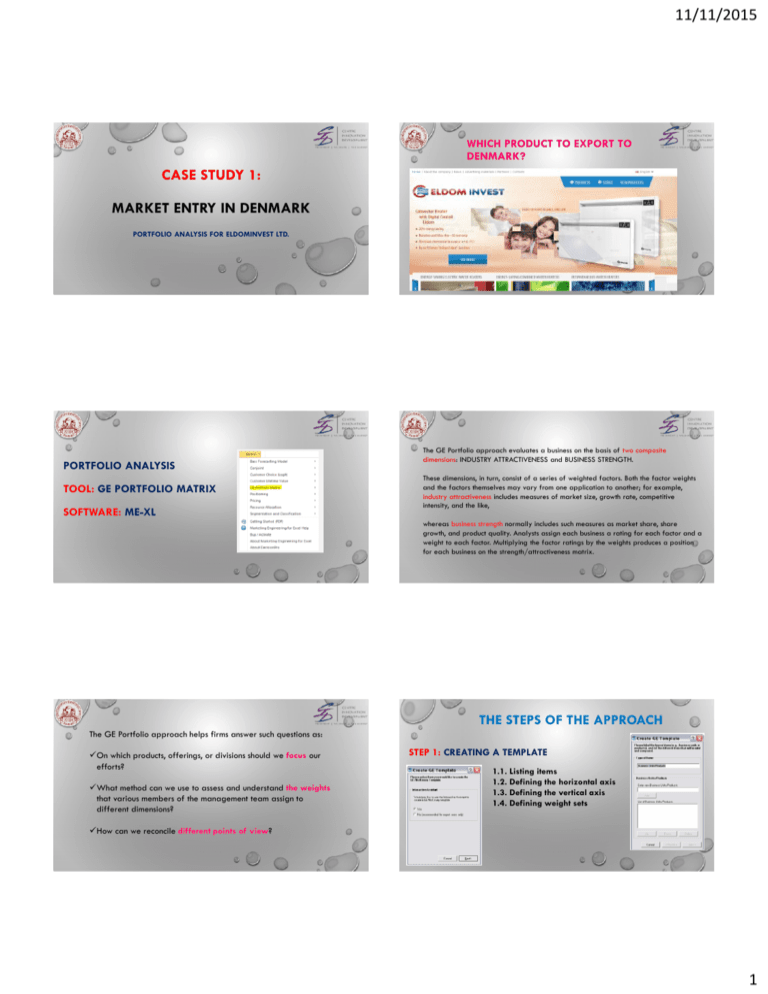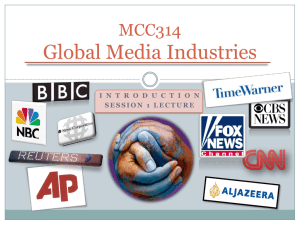CASE STUDY 1: MARKET ENTRY IN DENMARK
advertisement

11/11/2015 WHICH PRODUCT TO EXPORT TO DENMARK? CASE STUDY 1: MARKET ENTRY IN DENMARK PORTFOLIO ANALYSIS FOR ELDOMINVEST LTD. PORTFOLIO ANALYSIS TOOL: GE PORTFOLIO MATRIX SOFTWARE: ME-XL The GE Portfolio approach evaluates a business on the basis of two composite dimensions: INDUSTRY ATTRACTIVENESS and BUSINESS STRENGTH. These dimensions, in turn, consist of a series of weighted factors. Both the factor weights and the factors themselves may vary from one application to another; for example, industry attractiveness includes measures of market size, growth rate, competitive intensity, and the like, whereas business strength normally includes such measures as market share, share growth, and product quality. Analysts assign each business a rating for each factor and a weight to each factor. Multiplying the factor ratings by the weights produces a position for each business on the strength/attractiveness matrix. THE STEPS OF THE APPROACH The GE Portfolio approach helps firms answer such questions as: On which products, offerings, or divisions should we focus our efforts? What method can we use to assess and understand the weights that various members of the management team assign to different dimensions? STEP 1: CREATING A TEMPLATE 1.1. Listing items 1.2. Defining the horizontal axis 1.3. Defining the vertical axis 1.4. Defining weight sets How can we reconcile different points of view? 1 11/11/2015 THE TEMPLATE THREE PRODUCTS: 1. ELECTRIC HEATERS 2. HEAT PUMPS 3. BUFFER TANKS STEP 2: ENTERING THE DATA STEP 3: RUNNING ANALYSES STEP 4: INTERPRETING THE RESULTS 2 11/11/2015 Regression analysis, global markets CASE STUDY 2: BRICS COUNTRIES POTENTIAL HOST COUNTRIES FOR TURNKEY PROJECTS IMPLEMENTATION RESULTS FROM THE ANALYSIS (1) There are obvious differences in the structure of the globalisation process between BRICS, especially for the elements “personal contact” and “cultural proximity”. Two “jumps” in cultural proximity (1989 and 1997) are evident for China. Personal contact still remains at a low level with values quite similar to those of India. Russia is an interesting and challenging market. There is a serious “jump” in cultural proximity in 1998. During the last two years few negative trends are observed. There is a slight decline in information flows, actual flows and restrictions. There is a group of scholars and researchers (Distler, 2005; Laudicina, 2012) who suggest that the locus of global economic, political and demographic power has been shifting with growing intensity from Global North (developed countries) to Global South (developing countries) as well. Both trends affect global supply chains decisions, especially their sourcing locations as well as expansion strategies of the companies. Brazil could serve as a good example with few fluctuations during the years. Based on received results we can identify THREE MAIN AREAS for marketing interventions in global markets, namely financial efficiency, HR skills and business environment. Business environment interventions could be implemented by affecting country risk levels, infrastructure and security of international property. The second one, infrastructure, is particularly interesting because turnkey projects are usually used to develop and to implement infrastructure projects. The correlation analysis reveals the strongest relationship (Pearson coefficient 0.607, α = 0.000) of the effect of financial efficiency over total assessment of global competitiveness. We can conclude that the most frequent interventions on global markets are performed through financial tools. RESULTS FROM THE ANALYSIS (2) India differs a lot compared to the other BRICS countries. Political globalisation shows a permanent trend to increase while the growth rate for the rest of the factors is almost flat. There is a substantial rise in cultural proximity in 1995 but personal contact didn’t change during the analysed period. Regarding South Africa we can see a sharp improvement in cultural proximity in 1994 and a steady growth of political globalisation after 1994. Information flows and social globalisation are raising as well. 3 11/11/2015 BRIC: Comparative country risk assessment Despite the positive trends of overall globalisation the country risk levels are medium except Russia where the risk is quite high. South Africa is evaluated as A4 level for both parameters. The turnkey project marketing process: conceptual model Link to the figure POSITIONING OF BULGARIA BY GRDI, 2009 Risk 100 90 80 70 60 50 40 30 20 10 0 CASE STUDY 3: GRDI points GLOBAL RETAILERS STRATEGIES Market Attractiveness Time Pressure Bulgaria Market Saturation Russia Slovenia Latvia Romania Legend: Scale of assessment 0 to 100: High – Low risk; Low – High market attractiveness; Saturated – Unsaturated market; No time pressure – Urgency to enter 4 11/11/2015 High priority GRDI priori ty 5 years Low priority Bulgaria (2014) Source: A.T.Kearney. Windows of Hope for Global Retailers: The 2009 A.T.Kearney Global Retail Development Index, p. 3. THANK YOU FOR YOUR ATTENTION! 5









